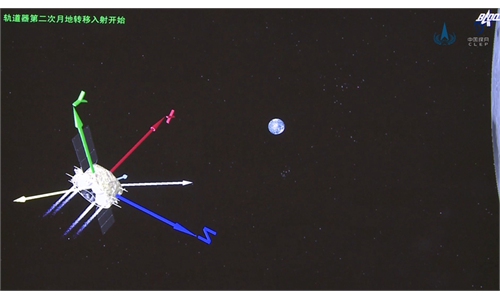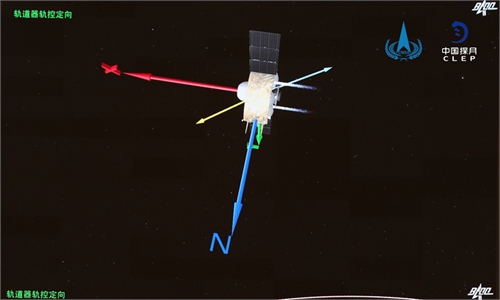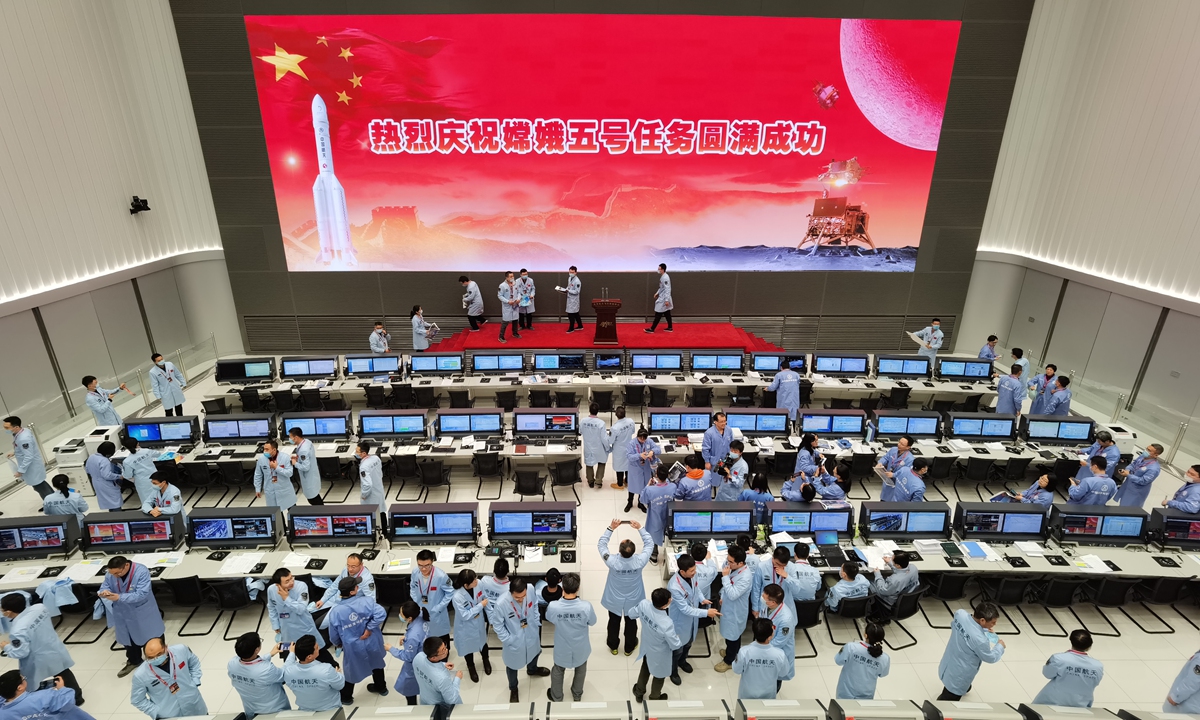
The photo taken on early Thursday morning shows Beijing Aerospace Control Center Photo: Our Space
Carrying around 2 kilograms of lunar samples, China's Chang'e-5 safely landed at its designated landing area in Siziwang Banner, North China's Inner Mongolia Autonomous Region around 2 am Thursday, bringing the craft's epic round trip between Earth and its celestial neighbor located some 380,000 kilometers away to a perfect conclusion.
According to the China's National Space Administration on early Thursday morning, the spacecraft's safe landing marks the successful completion of the country's first ever lunar material retrieving mission.
The CNSA said in a statement provided to the Global Times on Thursday morning that the retrieved re-entry capsule of Chang'e-5 will be transferred by air to Beijing, where it will be opened and the lunar sample container it carries will be taken out.
The CNSA will hold a hand-over ceremony to pass on the lunar samples to the ground application system, kicking off relevant work on storage, analysis and research of samples from outer space.
The parachute opened when the craft was some 10 kilometers above ground.
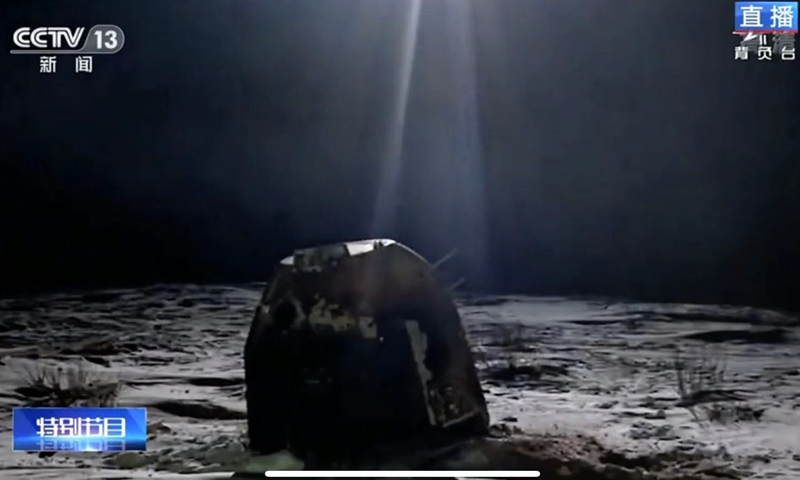
Re-entry module of Chang'e-5 lunar probe at the landing site in Siziwang Banner, North China's Inner Mongolia Autonomous Region on early Thursday morning. Photo: Screenshot of CCTV
China has now become the third country to successfully bring lunar materials back to Earth after the US and the Soviet Union.
The Chang'e-5 has now completed the last part of the 11-stage moon mission, which has seen many firsts in the country's aerospace history, such as the first-ever takeoff from the lunar surface, and the first rendezvous and docking at the lunar orbit, bringing a triumphant end to one of the most complex and challenging explorations in China's aerospace history.
Looking back at the targets set for the mission by its developer, the China Aerospace Science and Technology Corp, it is safe to say that Chang'e-5 has lived up to people's expectations in a steady manner. Its achievements include technological breakthroughs that have advanced China's aerospace industry, the country's first-ever sample-retrieval mission from an extraterrestrial body, and finally, a perfected moon exploration system that lays the foundation for future manned tasks and other deep-space projects.
Song Zhongping, an aerospace expert and TV commentator, told the Global Times that the mission "has paved the way for the next stage of exploration: application-oriented space projects."
"Now that China's moon exploration project has come to a perfect ending and gained plenty of experiences, China can focus its energy on making use of the resources on the moon," Song said.
It also verified a new unmanned, robotic approach to exploring space, which can allow men to travel to farther celestial bodies at reduced cost and risks, observers noted.
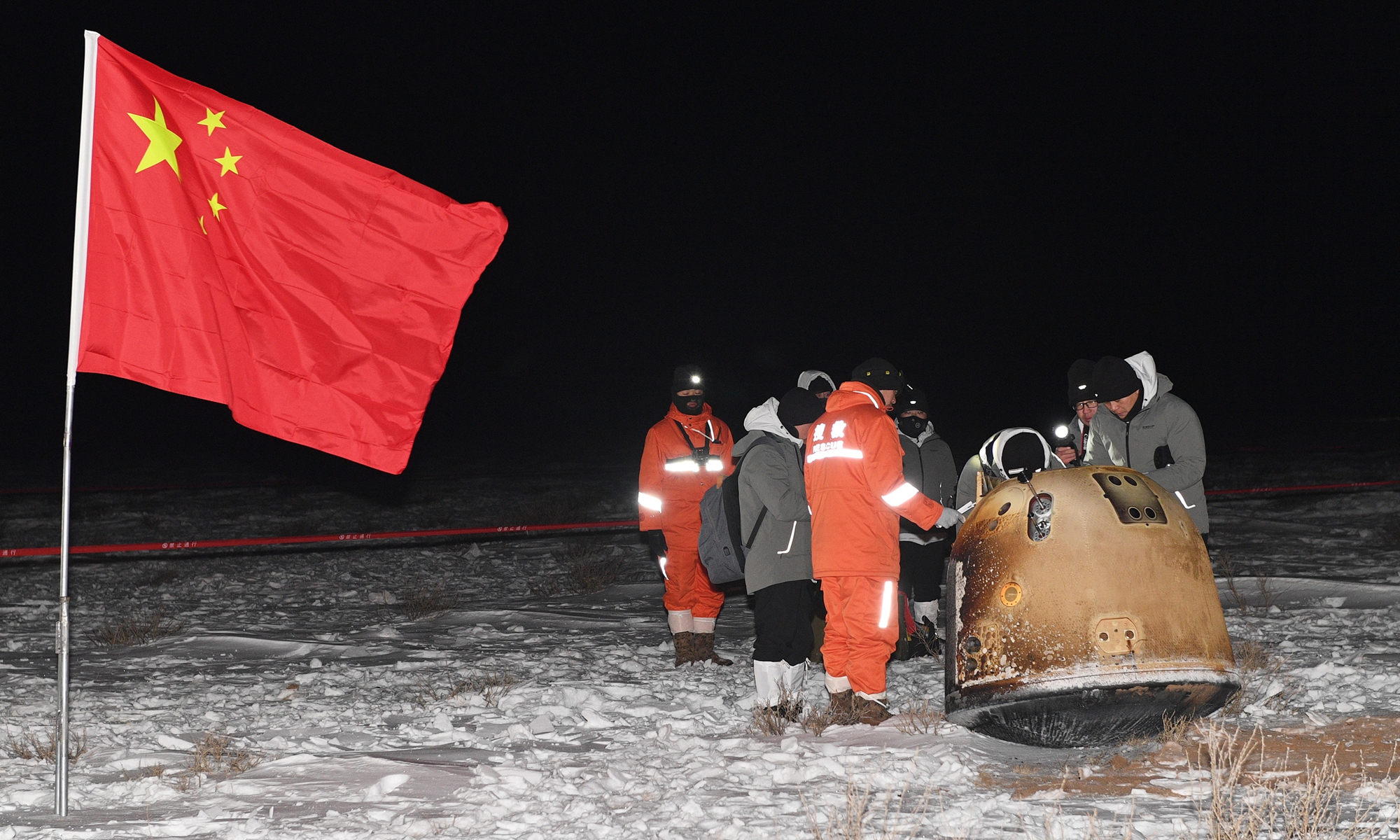
Photo: Wang Jiangbo/Our Space
Promise delivered
Shortly after Chang'e-5's launch, Chinese netizens dug up an article published in 2005 by the People's Daily, which laid out plans for the entire Chang'e series - orbiting, landing, and sample retrieval, while specifying that the missions were expected to be completed in 2020.
Fifteen years later, the timetable in the newspaper has finally been met. "It's hard to believe that our distant and unrealistic fantasies have come true, and the dream we lived in has become a reality," a netizen on China's Twitter-like Sina Weibo said in awe.
"The most distinctive feature and biggest advantage of China's aerospace industry is that we develop our missions step by step, and this has not drifted away from the original goal set decades ago thanks to a stable government and continuous policy," Wang Ya'nan, chief editor of Aerospace Knowledge magazine, told the Global Times on Thursday.
China's future Chang'e-6 mission is expected to automatically collect lunar samples for analysis and research, and hopefully carry international payloads on board.
Chang'e-7 will comprehensively explore the moon, while Chang'e-8 will explore the possibility of building an international lunar research base, Global Times previously learned from CNSA. Chang'e-8 will also test 3D printer technology in the hopes of assisting future lunar residents.
Now, the Chinese people have more reason to believe that the blueprints of future adventures - manned missions, moon base, Mars landing, even setting up permanent residence on other celestial bodies - are not far away from becoming a reality.
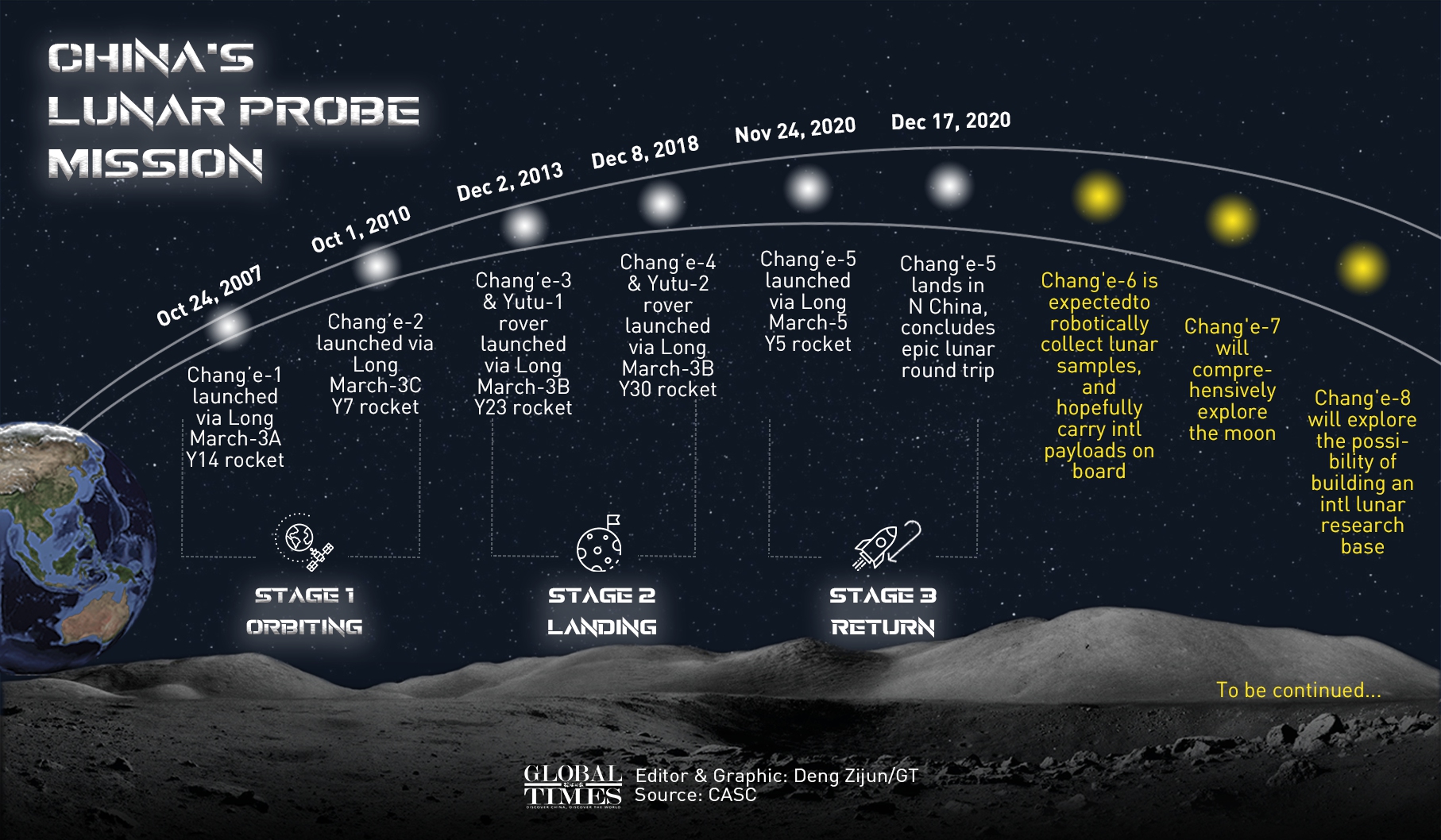
China's lunar probe mission Infographic: Deng Zijun/GT
Hi-tech input
China's Chang'e-5 adopted a skip re-entry method, which mimics stone skipping, to lower the speed of the craft as it enters the Earth's atmosphere, the second time a Chinese spacecraft has used this method on its return to Earth.
The skip re-entry process took around 15 minutes, according to Meng Zhanfeng, overall chief designer of Chang'e 5.
According to the developers of the method, the No.502 research institute under the China Academy of Space Technology (CAST), a subordinate of the state-owned aerospace giant China Aerospace Science and Technology Corporation (CASC), the skip re-entry method was first used in the test mission featuring Chang'e-5 Test 1, an experimental robotic spacecraft used for the eventual Chang'e-5 probe mission.
Before the re-entry of Chang'e-5, China had launched more than 20 return satellites, retrieved 11 Shenzhou spaceships and a new-generation manned spaceship, and the Chang'e-5 T1 craft.
Compared to return satellites and spacecraft which fly on the lower Earth orbit at the speed of first cosmic velocity or orbital speed of around 7.8 kilometers per second, the Chang'e-5 carrying lunar samples was flying at a speed of more than 11.2 km per second, the second cosmic velocity or escape velocity.
"The skip re-entry method is designed to consume the energy as the returner enters the atmosphere at a high speed, then springs out of it with the lift of the air, enabling it to plunge back into the atmosphere at a lower speed," developers said in a statement that CAST sent to the Global Times on Thursday.
The speed of the craft would be reduced to lower than first cosmic velocity, and after that the process will be familiar to all, as it is similar to that of a Shenzhou spaceship's re-entry, they said.
According to CAST, from the first dive into the atmosphere to the final landing, the Chang'e-5 returner will travel some 7,000 kilometers under robotic control.
This was made possible by a Guidance, Navigation, Control (GNC) system developed by the CAST 502 institute.
With the help of the GNC system, the craft will master its location, speed and other information in real-time fashion, automatically map out an optimal flight route from the current position to the site of parachute release and eventually fly to the landing site at the proper flight form and angle.
The GNC system has conducted countless flight experiments and simulated millions of possible flight routes, it said.
Two radar devices developed by the 23 institute under the Second Academy of the state-owned hi-tech giant China Aerospace Science and Industry Corp (CASIC) also provided real-time data to guide the search and recovery team to work effectively at the frontline, offering landing point forecasts as well as positioning services to locate the returning craft, CASIC told the Global Times.

A search and recovery team member wears the powered exoskeleton on Wednesday. Photo: CASIC
A new powered exoskeleton developed by the 206 institute under the CASIC Second Academy also contributed to the search and recovery mission.
The designers told the Global Times that the exoskeleton system has separate parts for both the upper and lower body, and has a load capacity of 50 kilograms. "The system strengthens its wearer, saving up to 60 percent of energy when carrying heavy loads," they said.
Two people on the search and recovery team were wearing the exoskeleton, and after they arrived at the landing point, they planted a Chinese national flag right next to the re-entry capsule.
Such a moment reminded many of the one when the first actual Five-star Red Flag was unfolded on the Chang'e-5 lander on moon surface on December 3.
The exoskeleton also allowed team members to establish emergency communication, searchlight and electricity supply systems in the area surrounding the re-entry capsule, to ensure the fast, safe and highly efficient execution of the search and recovery work.

Staff work at Beijing Aerospace Control Center on Thursday morning. Photo: Our Space
Global visions
The European Space Agency (ESA) helped China track the spacecraft as it entered the Earth's atmosphere, CCTV News reported.
Due to the continuous rotation of the Earth, there were some "blind spots" in which China's own control stations were unable to detect Chang'e-5's movements. To ensure that it could be tracked at all times during its journey, ESA deployed its stations to establish data transmissions with the probe, which allowed scientists to accurately ascertain its flight status.
Rafael Sahagun Schwartz, director of the Maspalomas station at ESA, said that the station used a parabolic antenna located near the equator to help monitor and pin down the probe's time of re-entry into the atmosphere, which helped determine where it landed.
Schwartz also expressed heartfelt recognition for China's significant contribution made by unveiling another unknown part of the moon, which enriched human beings' understanding of its celestial neighbor.
Wang Ya'nan said that the global cooperation on the Chang'e-5 mission reflected China's openness to the world, as well as international space-enthusiasts' eagerness to join hands in future space exploration projects.
"There are no national boundaries when it comes to aerospace dreams," he said.
Pei Zhaoyu, deputy director of the Lunar Exploration and Space Program Center of CNSA, told the media that "After receiving the lunar soil samples, we will disclose to the international community how to handle the regolith samples and will conduct research in accordance with that."
Pei in previous interviews said that China had put forward initiatives to the international community, hoping to cooperate with countries around the world to build an international lunar research station.
China has signed cooperation framework agreements with multiple international space agencies, including the UN Office for Outer Space Affairs, Russia's state space corporation Roscosmos and ESA.


